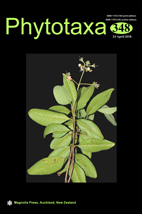Abstract
Magnolia mercedesiarum, a new species from the eastern slopes of the Andes in northern Ecuador, is described and illustrated, and a key to Ecuadorian Magnolia (subsect. Talauma) is provided. This species differs from M. vargasiana in having broadly elliptic leaves that have an obtuse base vs. suborbicular and subcordate to cordate, glabrous stipular scars, more numerous lateral veins per side and fewer stamens. It also differs from M. llanganatensis in having leaf blades broadly elliptic vs. elliptic, longer petioles, less numerous lateral leaf veins per side, larger fruits and more numerous petals and carpels. Using MaxEnt species distribution models and IUCN threat criteria, M. mercedesiarum has a potential distribution area of less than 3307 km² and is assessed as Endangered (EN): B1 ab (i, ii, iii). The relevance of systematic vegetation sampling in the discovery of rare species is highlighted.

